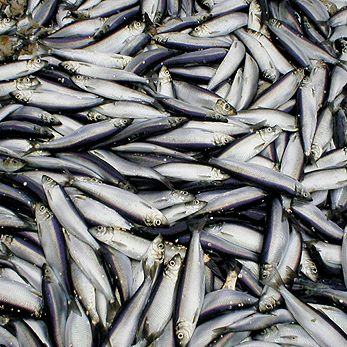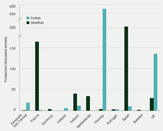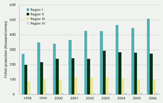Mariculture is the cultivation of marine organisms such as fish and shellfish for food and other products. In 2006, almost 1.5 million tonnes of farmed fish and shellfish were produced in the OSPAR area representing 4.2% of world mariculture production Figure 8.7. Since 1998, production of finfish in the OSPAR area has increased by 57% mainly due to increased production in Regions I and II Figure 8.8. Shellfish farming, which is most intensive to the south of Region II and in Region IV, remained stable over the same period.
There are many concerns linked to mariculture, both in relation to rearing practices and to the widespread exchange and movement of eggs, embryos and seed, especially when different eco-regions are involved. Examples of these concerns include genetic interaction between farmed fish and wild stocks, transfer of parasites and diseases, spread of non-indigenous species, and dependence on industrial catches of wild fish to feed fish in mariculture. There are also concerns over a number of site-specific impacts from mariculture facilities, including:
- Eutrophication as a result of nutrient enrichment from feeds and effluents.
- Competition between escaped farmed fish and wild stocks for spawning grounds in freshwater habitats.
- Release of chemicals used to prevent fouling of equipment or to treat parasites and diseases.
- Displacement of bird and seal populations as a result of the use of scaring devices to discourage predation of farmed fish.
- Impacts from the harvesting of shellfish and from seed collection for mussel farming.
Measures are in place to reduce impacts
OSPAR recommends best environmental practice (BEP) to reduce inputs of potentially toxic chemicals from aquaculture use. In addition, measures under OSPAR’s Eutrophication, Hazardous Substances and Biodiversity and Ecosystems Strategies provide a means to monitor, assess and regulate the impacts of mariculture. Various national and EU measures address the pollution and biodiversity impacts of mariculture. There are also international risk assessment protocols developed by ICES for assessing the risks of using non-indigenous species in aquaculture.
Use of hazardous substances has been reduced
Although OSPAR’s recommendations on BEP for the reduction of inputs of potentially toxic chemicals from aquaculture use are not fully implemented in national legislation, the aims do seem to have been taken up by national or EU legislation. Increased use and development of vaccines has considerably reduced the application of antibiotics in mariculture. Tributyltin (TBT) in anti-fouling agents for mariculture equipment has been replaced by copper-based substances. Concern has been raised about possible increases in the release of copper, especially in Regions I and II. It is likely, however, that apparent increases are actually an artefact of better monitoring and reporting and that the actual usage of copper may have even reduced.
Effects on wild populations need better understanding
Lice from farmed salmon have been linked to the decline in wild salmon and sea trout near salmon farms, but further evidence is needed to make a direct association. In 2007, the contribution of escaped salmon from mariculture to national catches in the North-East Atlantic was around 15% in Norway, but less than 2% in most other OSPAR countries. The main risks associated with escape of farmed fish are the displacement of wild fish and genetic interactions. An expansion of mariculture with a focus on carnivorous fish species is likely to increase demand for feed derived from industrial fishing of wild stocks. These issues show the need for a better understanding of interactions between fish farming and wild fish stocks.
Climate change may increase introduction of non-indigenous species
Increased sea temperatures have the potential to change the areas where introduced species can become established. Pacific oysters, introduced into the OSPAR area as a mariculture species, have established wild populations in France and as far north as Denmark and Sweden – areas previously thought too cold for them to reproduce. These introductions can lead to displacement of indigenous species with consequences for associated fauna.
Wider impacts should be kept under review
Mariculture activities are very diverse and impacts are site-specific. Regulation and control therefore need to be focused on a case-by-case approach. OSPAR countries should continue to implement the measures that are already in place to mitigate impacts from mariculture. OSPAR needs to keep under review the wider impacts, such as non-indigenous species, impacts of sea lice, escaped fish and increased demand for industrial fisheries, especially in the event of substantial increases in mariculture activities. If necessary, coordinated management may then be required. The need to adapt mariculture management approaches to climate change should also be reviewed.
Regional summary of past trends and outlook for mariculture





